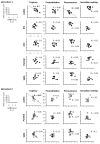Dorsolateral prefrontal γ-aminobutyric acid in men predicts individual differences in rash impulsivity
- PMID: 21757187
- PMCID: PMC3192031
- DOI: 10.1016/j.biopsych.2011.05.030
Dorsolateral prefrontal γ-aminobutyric acid in men predicts individual differences in rash impulsivity
Abstract
Background: Impulsivity is a multifaceted personality construct associated with numerous psychiatric disorders. Recent research has characterized four facets of impulsivity: "urgency" (the tendency to act rashly especially in the context of distress or cravings); "lack of premeditation" (not envisaging the consequences of actions); "lack of perseverance" (not staying focused on a task); and "sensation seeking" (engaging in exciting activities). Urgency is particularly associated with clinical populations and problematic disinhibited behavior.
Methods: We used magnetic resonance spectroscopy to measure concentration of the inhibitory neurotransmitter γ-aminobutyric acid (GABA) in the dorsolateral prefrontal cortex (DLPFC) in two cohorts of 12 and 13 participants.
Results: We find that variation in trait urgency in healthy men correlates with GABA concentration in the DLPFC. The result was replicated in an independent cohort. More GABA predicted lower urgency scores, consistent with a role in self-control for GABA-mediated inhibitory mechanisms in DLPFC.
Conclusions: These findings help account for individual differences in self-control and thus clarify the relationship between GABA and a wide range of psychiatric disorders associated with impaired self-control.
Copyright © 2011 Society of Biological Psychiatry. Published by Elsevier Inc. All rights reserved.
Figures




References
-
- American Psychiatric Association . Diagnostic and statistical manual of mental disorders. 4th ed., text rev ed Washington, DC: 2000.
-
- DeYoung C. Impulsivity as a personality trait. In: Vohs KD, Baumeister RF, editors. Handbook of Self-Regulation: Research, Theory, and Applications. Second ed Guilford Press; New York: 2010. pp. 485–502.
-
- Whiteside SP, Lynam DR. The Five Factor Model and impulsivity: using a structural model of personality to understand impulsivity. Personality and human differences. 2001;30:669–689.
-
- Smith GT, Fischer S, Cyders MA, Annus AM, Spillane NS, McCarthy DM. On the validity and utility of discriminating among impulsivity-like traits. Assessment. 2007;14:155–170. - PubMed
Publication types
MeSH terms
Substances
Grants and funding
LinkOut - more resources
Full Text Sources
Medical

